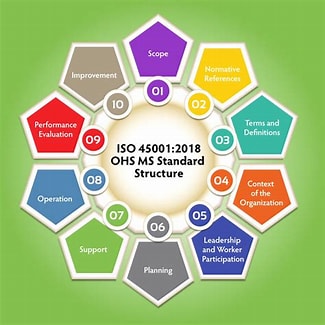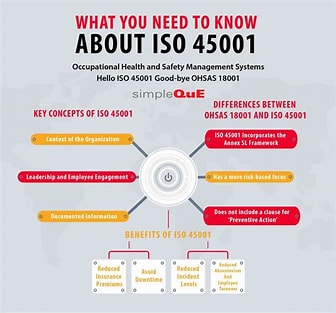Introduction
ISO 45001:2018 is the international standard for Occupational Health and Safety (OH&S) management systems, designed to ensure the well-being of employees by reducing workplace risks. One of the key differentiators of ISO 45001 from previous standards like OHSAS 18001 is the heightened focus on leadership commitment. The standard emphasizes that successful implementation is not just a matter of policies and procedures but is fundamentally driven by the active involvement of leadership. In this article, we will explore the crucial role that leadership plays in achieving ISO 45001 compliance and creating a culture of safety within the organization.
Defining Responsibilities: Leadership Commitment
ISO 45001 explicitly requires top management to take an active role in developing, implementing, and maintaining the OH&S management system. This means that leadership cannot simply delegate health and safety responsibilities to a safety officer or department. Instead, leaders must visibly support the initiative, making safety an integral part of the business strategy. Here’s what leadership commitment looks like under ISO 45001:
- Setting the OH&S Policy: Top management is responsible for defining the organization’s occupational health and safety policy, which must be aligned with its overall business objectives. This policy must demonstrate a commitment to preventing work-related injuries and illnesses and ensuring continual improvement in health and safety performance.
- Defining Roles and Responsibilities: Leaders are responsible for ensuring that roles and responsibilities related to health and safety are clearly defined, communicated, and understood throughout the organization. This includes appointing safety managers, forming safety committees, and making sure all staff understand their role in upholding safety standards.
- Providing Resources: Management must allocate the necessary resources (financial, human, and technological) to implement and maintain the OH&S system. Without adequate resources, it’s impossible to achieve the safety objectives set forth in the policy.
Setting the Safety Culture: Leadership’s Influence
The culture of an organization starts from the top, and this is especially true when it comes to safety. A positive safety culture encourages employees to take ownership of their own safety and the safety of others, creating an environment where potential risks are identified and mitigated before they escalate. Leadership sets the tone for this culture through:
- Visible Commitment: Leaders must lead by example, demonstrating that safety is a top priority by following safety procedures, wearing proper protective equipment, and participating in safety meetings. This visible commitment reinforces the importance of safety to the entire organization.
- Regular Communication: Communication from leadership on safety matters should be frequent and consistent. This includes discussing safety performance in meetings, issuing regular updates, and recognizing employee contributions to workplace safety.
- Encouraging Worker Participation: Engaging employees in the OH&S management system is vital for its success. Leadership must actively encourage worker participation in safety initiatives, hazard identification, and risk assessments. Involving workers not only improves the quality of the OH&S system but also fosters a sense of shared responsibility for safety.
Risk Management: Leadership’s Strategic Role
One of the most critical components of ISO 45001 is the risk-based approach to managing health and safety. Leaders must ensure that a comprehensive risk management process is in place, which includes identifying potential hazards, assessing risks, and implementing appropriate controls. Leadership’s role in this process includes:
- Proactive Risk Identification: Management must promote a proactive approach to hazard identification, encouraging employees to report hazards and near-miss incidents. By addressing risks early, the organization can prevent accidents and injuries before they happen.
- Strategic Risk Planning: Leaders must be involved in the strategic planning process, ensuring that health and safety risks are considered alongside other business risks. This helps integrate safety into overall business decision-making.
- Continuous Monitoring and Review: Leaders are responsible for ensuring that risk assessments are regularly updated and that control measures remain effective. This includes reviewing safety performance data, incident reports, and audit findings to identify areas for improvement.
Involving Employees: Building Trust and Engagement
ISO 45001 recognizes that employees are not just passive participants but active contributors to the success of the OH&S system. Leadership plays a crucial role in fostering employee engagement by:
- Empowering Employees: Leadership must empower employees to take part in safety decision-making, such as participating in risk assessments, safety committees, and audits. This gives employees a sense of ownership and responsibility for the OH&S system.
- Encouraging Reporting: An open-door policy is essential to create an environment where employees feel comfortable reporting hazards, near-misses, or safety concerns. Leaders should ensure there are no repercussions for reporting and should act swiftly to address any concerns.
- Recognizing Safety Contributions: Leadership can enhance engagement by acknowledging and rewarding employees who contribute to improving workplace safety. This could include recognizing teams for achieving safety milestones or implementing innovative safety solutions.
Continuous Monitoring and Review: Leadership Accountability
ISO 45001 requires organizations to continually monitor, measure, and review their OH&S performance to ensure the system’s effectiveness. Leadership is accountable for overseeing this process and making sure that the organization learns from past incidents to prevent future occurrences. This involves:
- Reviewing Safety Data: Leadership must regularly review data from internal audits, incident reports, and safety performance metrics to assess the health of the OH&S system. Trends should be analyzed to identify any recurring issues or emerging risks.
- Implementing Corrective Actions: When non-conformities or incidents occur, leadership is responsible for ensuring that corrective actions are taken promptly and effectively. This includes addressing the root causes of incidents to prevent recurrence.
- Driving Continuous Improvement: Leadership must demonstrate a commitment to continual improvement by setting new safety objectives, refining risk controls, and driving innovation in safety practices. This proactive approach ensures that the organization’s safety performance evolves with changing conditions and emerging risks.
Conclusion
The role of leadership in achieving ISO 45001 compliance is not limited to setting policies or delegating tasks—it is about taking an active and visible role in shaping the organization’s approach to health and safety. Strong leadership drives a culture of safety, empowers employees to engage in safety practices, and ensures the continuous monitoring and improvement of the OH&S management system. By prioritizing safety and demonstrating commitment, leaders can not only achieve ISO 45001 compliance but also create a safer, healthier, and more productive workplace.




Leave a Reply